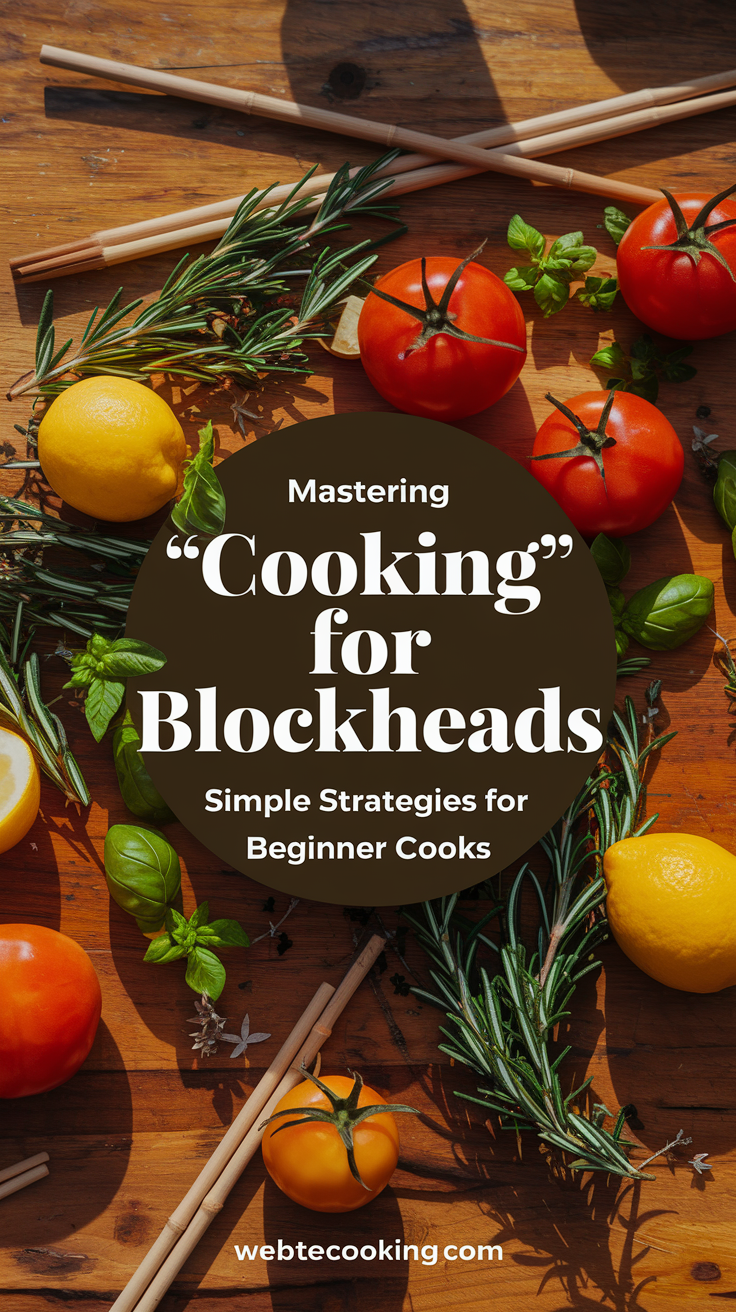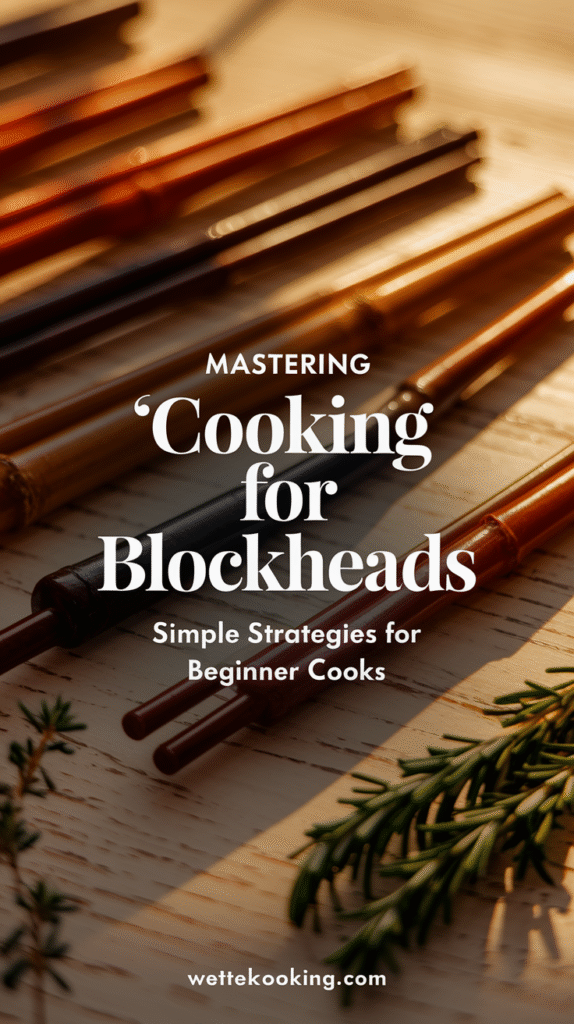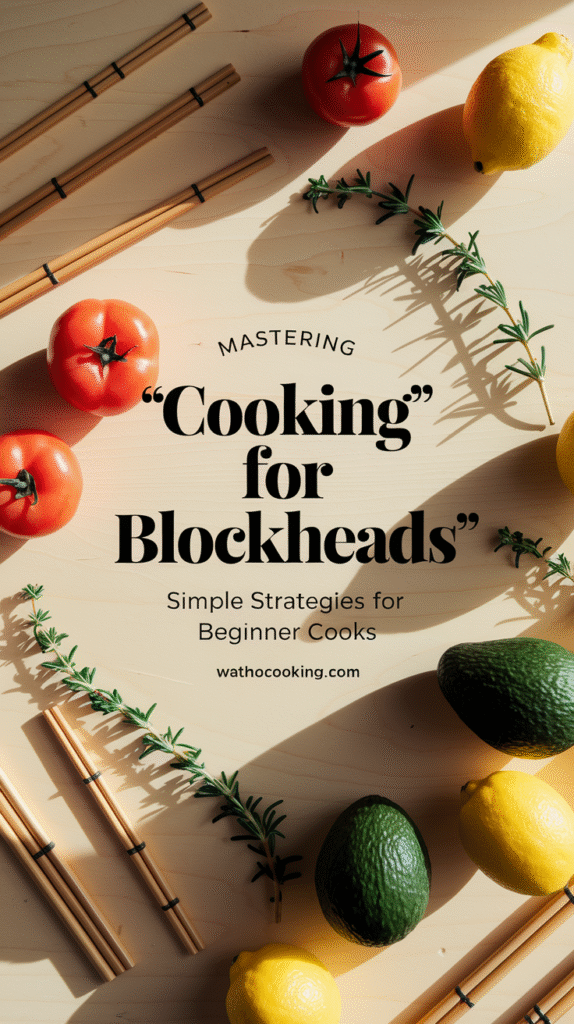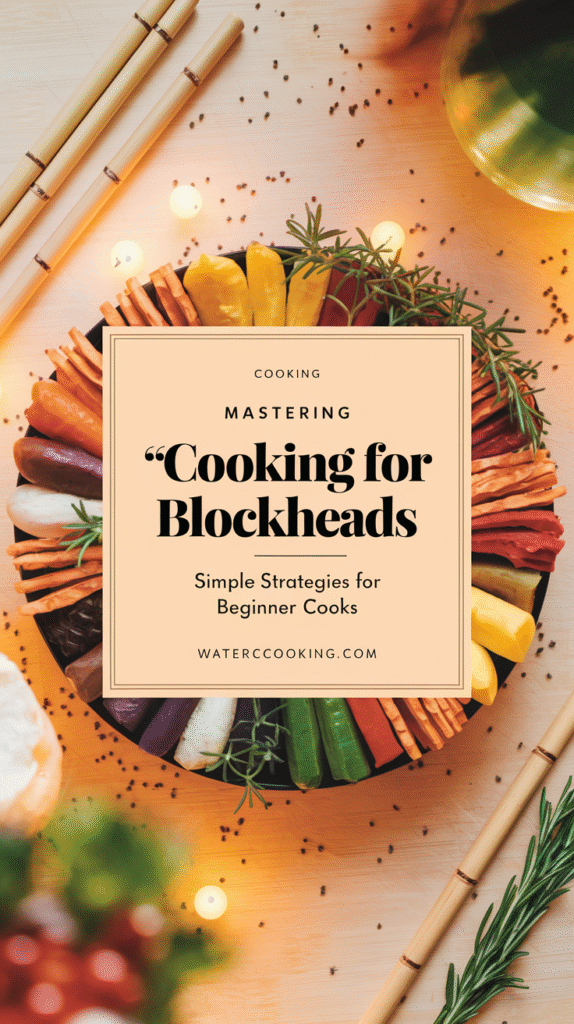Cooking can often feel overwhelming, especially for those new to the kitchen. Mastering “Cooking for Blockheads” is all about simplifying the process, making it enjoyable, and ultimately more productive. Here are some straightforward strategies to help beginner cooks navigate their culinary journey with confidence.
Understand Basic Cooking Terminology
Before diving into recipes, it’s crucial to familiarize yourself with some common cooking terms. Here’s a quick list that can help:
- Boil: To heat a liquid until bubbles form.
- Sauté: To cook food quickly in a small amount of oil.
- Simmer: To cook just below boiling point.
- Bake: To cook food evenly in an oven.
Understanding these terms makes it easier to follow recipes accurately. For a comprehensive glossary, consider checking out Cooking Light.
Start with Simple Recipes
When beginning your cooking adventure, opting for straightforward recipes is key. Look for dishes with few ingredients and clear instructions. Some great beginner-friendly options include:
- Scrambled Eggs
- Pasta with Marinara Sauce
- Stir-Fried Vegetables
- Grilled Cheese Sandwich
These recipes allow you to practice essential cooking techniques without feeling overwhelmed. Websites like Food Network offer a variety of easy-to-follow recipes that cater to novice cooks.
Invest in Basic Cooking Tools
Your kitchen doesn’t need to be packed with fancy gadgets. Focus on acquiring essential tools that will make a difference in your cooking:
- Chef’s Knife
- Cutting Board
- Measuring Cups and Spoons
- Non-stick Skillet
- Mixing Bowls
These items will cover most of your needs as a beginner cook. For more specialized tools down the line, consider looking at guides from Serious Eats.
Practice Mise en Place
Mise en Place is a French culinary practice that means “everything in its place.” It involves preparing your ingredients before cooking. This means chopping vegetables, measuring spices, and having everything ready to go. Here’s why it’s beneficial:
- Reduces stress while cooking.
- Helps keep your workspace organized.
- Allows for better cooking flow.
By engaging in this practice, you minimize the risk of missing ingredients, making your cooking experience much smoother.
Experiment with Flavoring
Learning to flavor your dishes is an exciting part of cooking. Start by experimenting with basic seasonings such as:
- Salt and Pepper
- Garlic Powder
- Fresh Herbs (like basil or parsley)
- Paprika or Chili Powder for some heat
Using these simple ingredients will enhance your dishes significantly. Don’t shy away from tasting throughout the cooking process; it’s the best way to learn how flavors develop.
Learn from Mistakes
Cooking is an art, and like any art form, it involves trial and error. Mistakes are part of becoming a better cook. Some tips to ease this process include:
- Keep notes on what went well and what didn’t.
- Try to tweak recipes instead of discarding them.
- Ask for feedback from friends or family.
Remember, even seasoned chefs have their off days. Learning from your experiences will build your skills and increase your confidence in the kitchen.
Stay Curious and Keep Learning
The world of cooking is vast and exciting. Keep your interest alive by:
- Watching cooking shows or YouTube tutorials.
- Reading culinary blogs.
- Joining local cooking classes.
By staying curious, you will continually enhance your skills while discovering new techniques and cuisines. For inspiring recipes and cooking techniques, visit Bon Appétit.
Mastering “Cooking for Blockheads” can start with these simple strategies. By understanding terms, choosing easy recipes, investing in the right tools, practicing mise en place, experimenting with flavors, embracing mistakes, and staying curious, you can pave the way for a fulfilling cooking journey.
Essential Kitchen Tools Every Blockhead Needs
When it comes to cooking, having the right tools can make a world of difference, especially for those who may feel a bit clueless in the kitchen. A well-stocked kitchen with essential tools can turn you from a blockhead into a confident home chef. Here’s a look at the must-have kitchen tools that can aid anyone, regardless of their cooking skills.
Basic Cooking Utensils
- Chef’s Knife: A sharp, versatile knife is the heart of any kitchen. This tool allows you to chop, dice, and slice with ease. Look for a knife that feels comfortable in your hand.
- Cutting Board: Protect your countertops and keep your knife sharp with a sturdy cutting board. Choose one made of wood or plastic that’s easy to clean.
- Measuring Cups and Spoons: Accurate measurements are key in cooking. A set of measuring cups and spoons ensures you get the amounts just right.
- Mixing Bowls: A variety of mixing bowls can be useful for combining ingredients. Opt for bowls that are microwave and dishwasher safe for versatility.
- Spatula: A flat spatula is a must for flipping foods like pancakes or burgers. Silicone spatulas are great because they won’t scratch your pans.
- Wooden Spoon: Perfect for stirring, a wooden spoon is gentle on cookware and doesn’t conduct heat.
Cookware Essentials
- Non-stick Frying Pan: Ideal for easy cooking and cleaning, a non-stick pan is great for everything from eggs to stir-fries.
- Stock Pot: This large pot is perfect for making soups, stews, or boiling pasta. Look for one that is heavy-bottomed for even heating.
- Baking Sheet: Essential for roasting vegetables or baking cookies, choose a rimmed baking sheet to prevent spills.
- Cast Iron Skillet: Known for its ability to retain heat, a cast iron skillet is perfect for searing and browning.
- Slow Cooker: A slow cooker allows you to prepare hearty meals without the fuss. Just set it and forget it!
Small Appliances
- Blender: A good blender can help you make smoothies, sauces, and soups. Look for one with multiple speed settings.
- Food Processor: Slice, chop, and shred ingredients quickly and efficiently with a food processor, making prep work a breeze.
- Toaster Oven: This appliance can toast and bake small items without having to heat up a large oven, saving time and energy.
Baking and Prep Tools
- Whisk: Perfect for combining ingredients and incorporating air into your mixtures, a good whisk is essential for baking.
- Peeler: A vegetable peeler makes removing skins simple and quick, especially for potatoes and carrots.
- Grater: Use a grater for cheese, citrus zest, or vegetables to add layers of flavor to your dishes.
- Rolling Pin: For anyone who enjoys baking, a rolling pin is essential for flattening dough.
Useful Gadgets
- Kitchen Timer: Avoid overcooking meals with a simple kitchen timer. Many phones have timers, but a dedicated one can be more convenient!
- Can Opener: A manual or electric can opener makes it easy to access canned goods for your recipes.
- Food Thermometer: This gadget ensures your meats are cooked to perfection and safe to eat.
Investing in these essential tools can simplify your cooking process and elevate your kitchen confidence. Whether you’re an aspiring chef or just someone who wants to whip up a quick meal, these tools can help streamline your efforts. If you want to explore more kitchen essentials, consider checking out resources like Serious Eats or Food Network for additional tips and equipment suggestions.
Remember, it’s not just about the tools you have but how you use them. With practice and a bit of patience, you can go from being a blockhead in the kitchen to someone who creates delicious meals!
Easy Recipes to Impress Your Friends and Family
Making a lasting impression with your culinary skills is easier than you might think. You don’t need to be a gourmet chef to whip up easy recipes that will delight your friends and family. Here are some straightforward meals and snacks that you can prepare without breaking a sweat.
Appetizers That Wow
Start the gathering off with a few eye-catching appetizers. These are quick to prepare and will set a fun mood for the evening.
- Stuffed Mini Peppers: Sweet mini peppers can be filled with cream cheese, herbs, and spices. Bake them for about 15 minutes at 350°F for a warm treat.
- Caprese Skewers: Thread fresh mozzarella balls, basil leaves, and cherry tomatoes on toothpicks. Drizzle with balsamic glaze for a gourmet touch.
- Spinach and Artichoke Dip: Combine cream cheese, sour cream, spinach, and artichoke hearts. Bake until bubbly and serve with tortilla chips.
Main Courses Made Easy
This section includes simple yet impressive main dishes that will steal the show at dinnertime.
- Lemon Herb Roasted Chicken: Season a whole chicken with lemon, garlic, and your favorite herbs. Roast it for about an hour and your home will smell divine!
- Pasta Primavera: Cook your choice of pasta and toss it with sautéed seasonal vegetables and a splash of olive oil. Top with grated Parmesan cheese for extra flavor.
- Sheet Pan Fajitas: Slice bell peppers, onions, and chicken. Season with fajita spice, spread on a baking sheet, and roast. Serve with tortillas.
Desserts That Delight
No meal is complete without a sweet finish. These desserts are sure to impress and are incredibly easy to prepare.
- Chocolate Covered Strawberries: Melt chocolate and dip fresh strawberries in it. Let them cool on wax paper, and you’ve got a fancy treat!
- No-Bake Cheesecake: Mix cream cheese, sugar, and whipped cream. Pour into a pre-made graham cracker crust and chill until set.
- Fruit Salad with Honey Lime Dressing: Chop your favorite fruits and mix them with a dressing made from honey and lime juice for a light finish.
Easy Beverage Options
Make sure to quench everyone’s thirst with delicious beverages that can be prepared in a snap!
- Mojito Mocktail: Muddle mint leaves, lime juice, and sugar. Top with soda water for a refreshing drink.
- Iced Lemonade: Mix fresh lemon juice with water and sugar. Serve chilled for a delightful summer drink.
- Fruit-Infused Water: Add slices of fruit to a pitcher of water. Let it sit for a while to develop a refreshing flavor.
Helpful Tips to Keep in Mind
While you’re preparing these easy recipes, keep a few tips in mind:
- Choose seasonal ingredients for better flavor and presentation.
- Prepare as much as you can ahead of time, so you can enjoy your company.
- Don’t be afraid to experiment! Adjust recipes to your taste preferences.
Where to Find More Recipes
If you’re looking for even more ideas, check out these helpful websites for detailed recipes and cooking tips:
With these easy recipes in your arsenal, you are all set to impress your friends and family. Enjoy cooking, and most importantly, have fun during the process!
Common Cooking Mistakes and How to Avoid Them
Cooking can be a fun and rewarding experience, but it’s easy to make mistakes along the way. By being aware of common cooking pitfalls you can create delicious meals and have a great time in the kitchen. Here are some frequent errors and tips on how to avoid them.
Overcrowding the Pan
One common mistake many cooks make is overcrowding the pan. When you add too many ingredients, it can cause the temperature to drop, resulting in steaming rather than browning. This affects the flavor and texture of your dish.
To avoid this pitfall, make sure there is enough space between your ingredients.
- Cook in batches if necessary.
- Use a larger pan for bigger quantities.
Not Prepping Ingredients
Jumping into the cooking process without prepping your ingredients can lead to chaos. Chopping vegetables while your pan is hot can result in burnt ingredients or missed cooking times. It’s essential to have everything ready before you start cooking.
Follow these steps to make your cooking flow more smoothly:
- Chop, measure, and organize all ingredients before cooking.
- Label your ingredients if you’re planning to cook multiple dishes.
Ignoring the Recipe
Recipes are like road maps to successful cooking. Ignoring them or not reading them completely can lead to disastrous results. Whether you’re making a simple pasta dish or a complex dessert, following the recipe step-by-step is vital.
Here are tips to ensure you follow the recipe correctly:
- Read the recipe entirely before starting.
- Prepare to measure ingredients as specified.
Using the Wrong Size Pots and Pans
Using the wrong size pots and pans can affect cooking times and even outcome. A small pot may not allow for proper heat circulation, while a pan that is too large can dry out your food.
| Pot/Pan Size | Best Use |
|---|---|
| Small | Great for sauces and small portions |
| Medium | Perfect for family meals and sides |
| Large | Ideal for batches and large portions |
Always choose the appropriate size to ensure effective cooking.
Under-seasoning
There’s nothing worse than a bland meal! Many cooks fear over-seasoning and end up under-seasoning their dishes. Herbs, spices, and salt are essential for enhancing flavor.
To prevent this, taste your food as you go and adjust accordingly. Here are some points to consider:
- Use fresh herbs for the best flavor.
- Remember that salt can elevate other flavors.
Not Heating the Pan
Adding ingredients to a cold pan can lead to uneven cooking. When you don’t preheat your pan, it can also result in sticking or burning. A hot pan helps to sear and lock in flavors.
Here’s how to properly heat your pan:
- Allow your pan to warm up for a few minutes.
- Add oil once the pan is heated, and watch for it to shimmer.
Not Using Fresh Ingredients
Using expired or wilted ingredients can ruin your dish. Fresh ingredients not only taste better, but they also contain more nutrients. Ensure that everything you use is quality produce, dairy, or meat.
To maintain freshness, consider the following:
- Store perishables properly to extend their life.
- Use seasonal ingredients whenever possible.
By keeping these common cooking mistakes in mind, you can enhance your culinary skills and enjoy the process. For more culinary tips and recipes, visit Serious Eats or check out Food Network for inspiration.
Meal Planning Tips for the Culinary Novice
Embarking on your meal planning journey can be both exciting and daunting. For the culinary novice, meal planning is a great way to save time, reduce stress, and ensure you’re eating healthy meals throughout the week. Here are some essential tips to get you started on the right path.
First, it’s important to set realistic goals. Start by assessing your cooking skills and the time you realistically have for preparing meals. It’s okay to start small. Choose a couple of meals each week instead of overhauling your entire diet. This approach will help you gain confidence without feeling overwhelmed.
Gather Your Tools
Having the right kitchen tools can make meal planning much easier. Here’s a simple list of items you might need:
- Sharp knives
- Cutting board
- Measuring cups and spoons
- Mixing bowls
- Food storage containers
- Pans and pots of various sizes
Select Simple Recipes
Choosing simple recipes is key for beginners. Look for meals that have fewer ingredients and straightforward instructions. Websites like Love and Lemons offer a variety of straightforward and delicious recipes. Consider these aspects when selecting recipes:
- Familiar ingredients
- Minimal cooking techniques
- Short prep and cooking times
Plan Your Meals
Start planning your meals for the week. It helps to write down what you want to cook for each day, including breakfast, lunch, and dinner. You can use a simple template or app to organize everything. A helpful technique is to choose a theme for each day, such as:
- Meatless Monday
- Taco Tuesday
- Wrap Wednesday
- Thrifty Thursday (using leftovers)
- Fry-up Friday
By assigning themes, it makes decision-making easier and keeps meals exciting. Use a meal planning app like Mealime to help simplify this process. These apps can generate shopping lists based on your selected meals!
Create a Shopping List
Now that you have your meals planned, it’s time to make a shopping list. Organize your list based on the layout of your local grocery store to make your shopping experience as efficient as possible. Here’s a helpful way to categorize your shopping list:
| Category | Items |
|---|---|
| Produce | Fruits, Vegetables |
| Proteins | Meats, Tofu, Beans |
| Dairy | Milk, Cheese, Yogurt |
| Grains | Rice, Pasta, Bread |
| Condiments | Spices, Sauces, Dressings |
Prep Ahead of Time
If you can, take some time to prep ingredients on the weekends. Chop veggies, marinate proteins, or even cook up batches of grains. This will save you tons of time during busy weekday dinners. Set aside an afternoon to prepare and store prepped items in labeled containers for easy locating throughout the week.
Embrace Leftovers
Don’t shy away from leftovers! They can provide a quick meal option for lunch or dinner the next day. Get creative with them. For example, roasted veggies can easily be added to omelets or salads, while chicken can top a quick bowl of rice.
Meal planning is a fantastic way for culinary novices to build their skills while staying organized and healthy. As you become more comfortable in the kitchen, don’t hesitate to try new recipes and experiment with different flavors. Take advantage of resources like Simply Recipes for guidance, tips, and inspiration.
Remember, the aim is not perfection but progress. Enjoy the process of cooking as you nurture your meal-planning skills, one delicious dish at a time!
Conclusion
Becoming a confident cook is entirely achievable, even if you consider yourself a “blockhead” in the kitchen. By mastering simple strategies tailored for beginners, you can transform your cooking skills and create delicious meals that will impress your friends and family. Equipping yourself with essential kitchen tools is crucial, as the right utensils simplify the cooking process and help you execute recipes smoothly.
With easy-to-follow recipes designed for novice cooks, you’ll soon discover that you can whip up dishes that not only taste great but also showcase your newfound abilities. Remember, mistakes are part of the learning process. Identifying common cooking errors and understanding how to avoid them will put you a step ahead in your culinary journey.
Meal planning is another fantastic way to build your confidence. It helps streamline your cooking and ensures you have the ingredients needed to make your favorite dishes without stress. By organizing your meals, you also set yourself up for success, making your time in the kitchen enjoyable rather than overwhelming.
Embrace your identity as a “blockhead” and use these strategies to build your culinary skills. With practice and the right tools, you’ll transform from a novice to a competent cook in no time. Cooking is not just about preparing food; it’s a creative outlet and a way to connect with others. So, roll up your sleeves, put on your apron, and enjoy your exciting cooking adventure!







Leave a Reply